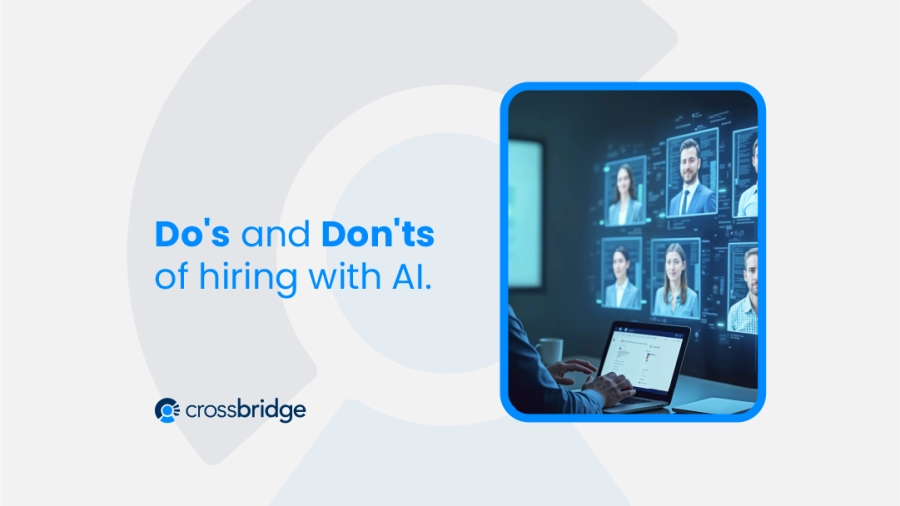Let’s be honest—AI is everywhere. It’s writing emails, answering support tickets, even trying to predict who you should hire next. And while we know it can be helpful, we believe successful hiring still depends on human instincts, conversations, and context.
At Crossbridge, we’ve seen firsthand that the best hires happen when people lead the process. That said, we also get that AI has its place—as long as it’s kept in check.
So here’s a quick guide to the Do’s and Don’ts of hiring with AI—for teams that want to get smarter, not colder.
DO: Use AI for admin and logistics, not decisions
Need help scheduling interviews or sending out reminders? AI’s great for that. Automation can save hours and help keep the hiring process organized and on track.
According to LinkedIn’s Future of Recruiting 2024 report, 74% of recruiters believe automation will allow them to focus more on the human side of hiring—like building relationships and spotting potential.
But when it comes to deciding who moves forward? That’s a job for people. Always.
DON’T: Use AI resume screeners
This one’s a hard no for us.
AI screeners might seem efficient, but they often miss nuance and create a weird tech arms race. Candidates use ChatGPT and AI tools to “optimize” their resumes, sometimes even fabricating experience just to game the algorithm.
So what happens? The bots talk to the bots, and you lose sight of who the candidate actually is.
AI isn’t equipped to measure cultural fit, coachability, or values alignment. These qualities show up in conversations, not data sets, and that’s why we believe real people need to review resumes.
It’s not about perfection on paper. It’s about fit in real life.
DO: Use AI to reduce some bias
AI can help structure parts of your hiring process—like interview question frameworks or skill-based assessments. These can promote consistency and reduce some bias… in theory.
But let’s be clear: AI is only as fair as the data it’s trained on. And most training data reflects historical bias.
A Harvard Business Review study found that AI systems trained on past hiring data often perpetuate bias, even when built with good intentions.
That’s why humans need to review the outputs and keep asking: Is this fair? Is this inclusive? Are we missing something—or someone?
DON’T: Sacrifice candidate experience
Yes, AI can streamline. But overdoing it makes candidates feel like just another ticket in your system.
Glassdoor reports that 58% of job seekers value clear, human communication during the hiring process—and honestly, who doesn’t?
If your emails, screening questions, or rejection messages feel overly templated or cold, it’s a missed opportunity to build trust (and your employer brand).
DO: Be transparent about where AI fits in
If you’re using AI in your hiring process, say so. Transparency builds trust—and in some places, it’s now the law.
In New York City, companies must disclose and audit the use of AI in hiring decisions (and more jurisdictions are adopting similar measures).
Let candidates know where AI is used and where it’s not. It shows respect—and reassures them that a real person is behind the important parts.
DON’T assume AI is one-size-fits-all
Every role is different. Every team has its own vibe. What works for hiring engineers might not work for hiring creatives—or leaders.
Over-automating your process risks missing the nuance that makes a great hire truly great.
At Crossbridge, we don’t just look at resumes—we look at context, career arcs, communication style, and cultural alignment. That kind of matchmaking? Still very human.
Interested in a people-first recruitment process for your tech team? let’s talk!
Final Thoughts
AI is a tool, not a hiring manager.
Yes, it can help streamline and support your process—but it can’t replace human judgment, emotional intelligence, or gut instinct. The stuff that really matters.
So if you’re using AI, use it with intention. Keep the human in the loop.
TL;DR – Quick Do’s & Don’ts Recap
| ✅ Do This | ❌ Not That |
| Automate admin tasks | Let AI make hiring decisions |
| Build structured interview guides | Use AI resume screeners |
| Use AI to support—not replace—equity | Assume AI is free from bias |
| Be transparent with candidates | Hide your use of AI |
| Keep the human touch | Over-automate the experience |
Sources:
- Harvard Business Review, “How AI Is Biased in Hiring — and What to Do About It”
- NYC AI in Hiring Law, 2023
